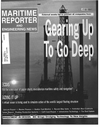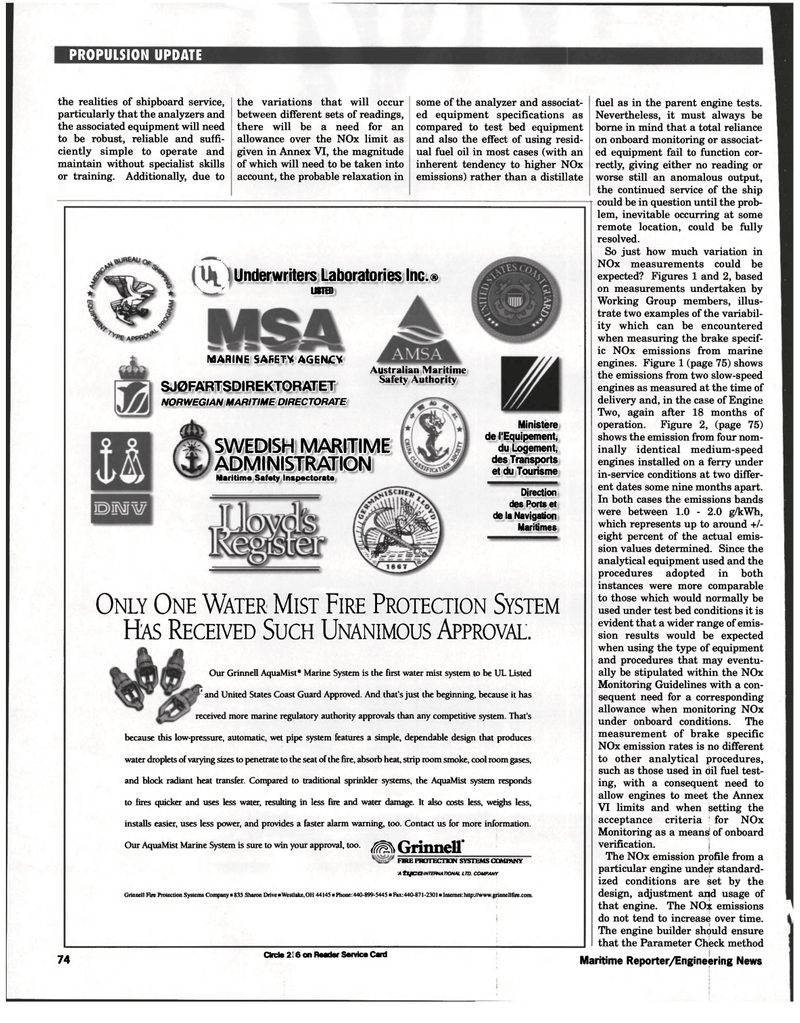
Page 82: of Maritime Reporter Magazine (April 1998)
Read this page in Pdf, Flash or Html5 edition of April 1998 Maritime Reporter Magazine
PROPULSION UPDATE the realities of shipboard service, particularly that the analyzers and the associated equipment will need to be robust, reliable and suffi- ciently simple to operate and maintain without specialist skills or training. Additionally, due to the variations that will occur between different sets of readings, there will be a need for an allowance over the NOx limit as given in Annex VI, the magnitude of which will need to be taken into account, the probable relaxation in some of the analyzer and associat- ed equipment specifications as compared to test bed equipment and also the effect of using resid- ual fuel oil in most cases (with an inherent tendency to higher NOx emissions) rather than a distillate <3 Underwriters Laboratories Inc.® una
MARINE SAFETY AGENCY
SJ0FARTSDIREKTORATET
NORWEGIAN MARITIME DIRECTORATE
Australian Maritime
Safety Authority
SWEDISH MARITIME ADMINISTRATION
Maritime Safety Inspectorate
Ministere de I'Equipement, du Logement, des Transports et du Tourisme
Direction des Ports et de la Navigation
Maritimes
ONLY ONE WATER MIST FIRE PROTECTION SYSTEM
HAS RECEIVED SUCH UNANIMOUS APPROVAL.
Our Grinnell AquaMist® Marine System is the first water mist system to be UL Listed ' and United States Coast Guard Approved. And that's just the beginning, because it has received more marine regulatory authority approvals than any competitive system. That's because this low-pressure, automatic, wet pipe system features a simple, dependable design that produces water droplets of varying sizes to penetrate to the seat of the fire, absorb heat, strip room smoke, cool room gases, and block radiant heat transfer. Compared to traditional sprinkler systems, the AquaMist system responds to fires quicker and uses less water, resulting in less fire and water damage. It also costs less, weighs less, installs easier, uses less power, and provides a faster alarm warning, too. Contact us for more information.
Our AquaMist Marine System is sure to win your approval, too. GlinilCll*
FIRE PROTECTION SYSTEMS COMPANY
A tlfCOINTERNATIONAL LTD. COMPANY
Grinnell Fire Protection Systems Company >835 Sharon Drive•Westlake.OH 44145 "Phone:440-899-5445 •Fax:440-871-2301 •Internet:http://www.grinnellfire.com. 74 Circle 264 on Reader Service Card fuel as in the parent engine tests.
Nevertheless, it must always be borne in mind that a total reliance on onboard monitoring or associat- ed equipment fail to function cor- rectly, giving either no reading or worse still an anomalous output, the continued service of the ship could be in question until the prob- lem, inevitable occurring at some remote location, could be fully resolved.
So just how much variation in
NOx measurements could be expected? Figures 1 and 2, based on measurements undertaken by
Working Group members, illus- trate two examples of the variabil- ity which can be encountered when measuring the brake specif- ic NOx emissions from marine engines. Figure 1 (page 75) shows the emissions from two slow-speed engines as measured at the time of delivery and, in the case of Engine
Two, again after 18 months of operation. Figure 2, (page 75) shows the emission from four nom- inally identical medium-speed engines installed on a ferry under in-service conditions at two differ- ent dates some nine months apart.
In both cases the emissions bands were between 1.0 - 2.0 g/kWh, which represents up to around +/- eight percent of the actual emis- sion values determined. Since the analytical equipment used and the procedures adopted in both instances were more comparable to those which would normally be used under test bed conditions it is evident that a wider range of emis- sion results would be expected when using the type of equipment and procedures that may eventu- ally be stipulated within the NOx
Monitoring Guidelines with a con- sequent need for a corresponding allowance when monitoring NOx under onboard conditions. The measurement of brake specific
NOx emission rates is no different to other analytical procedures, such as those used in tiil fuel test- ing, with a consequent need to allow engines to meet the Annex
VI limits and when setting the acceptance criteria for NOx
Monitoring as a means? of onboard verification.
The NOx emission profile from a particular engine under standard- ized conditions are set by the design, adjustment and usage of that engine. The NOx emissions do not tend to increase over time.
The engine builder should ensure that the Parameter Check method
Maritime Reporter/Engineering News

 81
81

 83
83
